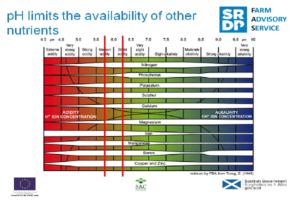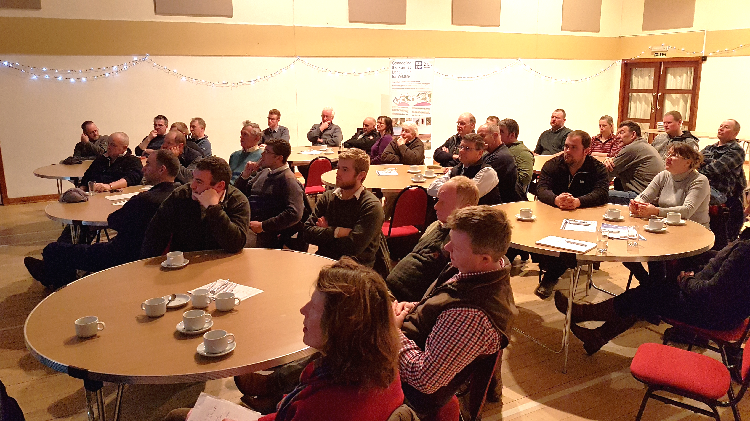Inverness Soil & Nutrient Network: First meeting event summary
5 January 2020The first meeting of the Inverness Soil & Nutrient Network was held in early December 2019 and the primary focus was: The Truth About Trace Elements
When considering soil health on the farm it is important that the limiting factors are understood. These can vary from season to season. Key considerations include: has the soil been regularly inspected and assessed, digging to ascertain the condition of the soil profile? When inspected is consideration given as to why there might be compaction; a lack of worms or the presence of undecomposed organic matter? Cultivation depths and techniques can then be appropriately selected.
Soil analysis is an essential tool in adding not only crop growth but soil health. The basic soil analysis that has been used for several decades is really only aimed at selling and making fertiliser recommendations it concentrates on producing what grows above ground. A more detailed analysis helps highlight detail which provides a vital resource in understanding how soils should be managed.
While soil type and series are useful descriptors and identifiers they can vary considerably in their clay, silt and sand contents. Measuring Cation Exchange Capacity (CEC) enables the calculation of the base saturation targets for the major cations in the soil, Calcium, Magnesium, Potassium and Sodium. These numbers vary considerably from a sandy soil to a clay soil.
Therefore, it could be the nutrients and minerals that are the limiting factors in a farm's soil and crop performance. It is not always a deficiency that is a limitation; it can be an excess that is proving antagonistic toward another element e.g. excess Potash will limit Magnesium. Soil condition can also be compromised by an excess of Magnesium in relation to Calcium, the excess making the soil sticky and hard to work as well as poorly draining.
Calcium is the king of nutrients regarding soil and plant health. It is often only considered of importance for adjusting pH; this misconception needs changing. Soil structure is greatly improved by the application of Calcium as it helps aggregate the soil creating ta profile that has airspace, allowing drainage and root development in an aerobic environment. Soils provided with enough Calcium supply plants which are structurally strong as Calcium is vital for cell formation and any shortage will see cell disintegration and increased fungal and pest damage.
Crop quality is significantly enhanced when Calcium is well supplied particularly in more susceptible crops e.g. potatoes (reduces IRS) and Green veg (reduces tip burn). This leads to better storage potential for the harvested crop. Forage crops see an improvement in cell wall digestibility and therefore better conversation factors from grass for milk and meat.
Soil pH and its maintenance at target levels is a key management decision for any farmer. No fertiliser should be applied to a mineral soil where this decision is not being made as it is wasteful. The optimum availability for most important nutrients is at a pH of between 6-6.5 as illustrated on the chart below.
What should be considered when interpreting soil pH results is that it is not only Calcium that alters this value; Magnesium, Potassium and Sodium also have an effect, therefore, fields high in any of the later 3 can still have a low Calcium. It is vital that more detailed soil analysis is carried out and Calcium analysis is a standard inclusion.
Grades of agricultural lime that can be marketed under the 1991 Fertiliser Regulations
| Sieve Size | Ground Lime | Screened Lime | Course Screened |
|---|---|---|---|
| 5mm | 100 | 100 | 100 |
| 3.35 | 95 | 95 | 90 |
| 150 micron | 40 | 20 | 15 |
The table above lists the grades of agricultural lime that can be marketed under the 1991 Fertiliser Regulations. There is significant analytical evidence that a third of what is being sold on to farm is not legally Ag Lime. The rest is commonly the lower grades, not ground lime.
This low-quality lime has a poor reactivity which is of little use to the farmer. Do not buy just on price and NV, granulometry is considered more important because this drive’s reactivity. An Aglime Quality Standard (AQS) certificate should be provided by the contractor and quarry to show what grade a farm is being supplied; if this is not forthcoming before delivery buy from another supplier.
There is a lot of talk about micronutrients and perceived deficiencies, but when the basics of soil management are not taken care of first there will always be a need to provide these elements 'out of a bottle' at a greater cost.
Ensure that a soil is properly analysed in detail with good interpretation as there could be several interactions taking place that are limiting the availability of micronutrients. Ensuring a soil is well supplied with Calcium will help make available and aid the transport of several nutrients into the plant, for example, B & Zn need adequate Calcium to be transported up through the roots via Xylem flow.
Therefore, with micronutrient, find out why these elements are not available; is it a natural deficiency of a lock-up (e.g.excess Phosphate can lock out Cu, Zn & Fe)? Treatment may be required in the short term but longer-term it may well be possible to supply them from organic manures and soil OM as these can be significant stores of micronutrients.
In summary use analysis from all sources to make accurate management decisions that will improve soil plant and animal health.
Our guest speakers during this event were Gavin Elrick from SAC Consulting and Mark Tripney from iSoils Ltd. You can download their presentations slides from the download links below.
Meddat Farm is one of 12 current Soil & Nutrient Network host farms fro the Soil & Nutrient Network. The host farms are located across Scotland and provide a venue and discussion topics for meetings throughout the year. Use this link for more information about current and former host farms and to read meeting notes from previous events.
- Technical Note (TN712): Land Management for Butterflies
- This technical note provides guidance on best practice land management to support and encourage butterflies and their habitats.
- Topics: Biodiversity and Environment
- Technical note (TN732): Recommended Grass and Clover Varieties 2019-2020
- The first meeting of the Inverness Soil & Nutrient Network was held in early December 2019 and the primary focus was: The Truth About Trace Elements When considering soil health…
- Technical Note (TN656): Soils Information, Texture and Liming
- This technical note offers information on soil, including classification, texture, PLANET Scotland and lime recommendations.
- Topics: Soils
- Technical Note (TN721): Soil Biodiversity and Soil Health
- This technical note examines soil biodiversity and soil health, and the steps you can take to improve both health and biodiversity in soils.
- Technical Note (TN720): Assessment for Agricultural Drainage Requirement
- This technical note examines drainage on agricultural land including the benefits, assessing for drainage, topography and possible issues.
- Technical Note (TN728): Planning Agricultural Field Drainage
- Agricultural drainage needs to be designed to suit the climate, ground conditions and crops to be grown. This technical note covers drainage taking into account areas, climate and topography.
- Technical Note (TN726): Fertiliser Recommendations for Grassland Scotland
- Limitations to grass production are temperature, moisture, soil pH, soil drainage and structure, and nitrogen (N). This technical note shows how to calculate the optimal amount of N that should be applied.
- Technical Note (TN714): Liming Materials and Recommendations
- This technical note examines soil pH, choosing liming materials and lime recommendations for different soils.
- Technical Note (TN699): Agricultural use of Biosolids, Composts, Anaerobic Digestates and other Industrial Organic Fertilisers
- Organic fertilisers such as biosolids, composts, anaerobic digestates and industrial wastes can be useful and cost-effective crop nutrient sources that can improve soil quality. This technical note outlines their use in agriculture.
- Topics: Climate Change, Soils and Water Management
- Farmer’s guide to sourcing and using digestate and compost
- Thinking of using digestate or compost? This guide from Zero Waste Scotland in association with NFUS can help you choose the right product. The guidance gives you key questions to ask to support you through the process of sourcing and using compost and digestate to help make sure the materials will meet your requirements.
- Topics: Climate Change, Soils and Water Management
- Technical Note (TN700): Bumblebees and the Importance of Pollination
- This technical note explains the importance of bumblebees, their requirements and how farmers can help support bees
- Technical Note (TN715): Phosphate and Potash Recommendations for Crops Grown in Highland and Islands
- This is an examination of phosphate and potash recommendations based on soils in the Highlands and Islands.
Sign up to the FAS newsletter
Receive updates on news, events and publications from Scotland’s Farm Advisory Service


